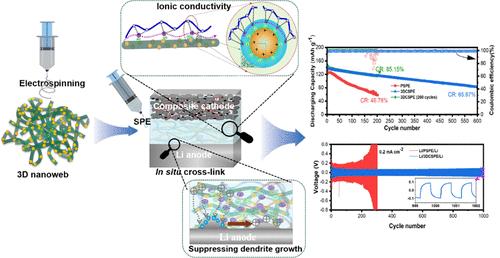Ferroelectric 3D Nanoweb-Incorporated In Situ Cross-Linked Composite Solid Electrolyte for High-Performance Lithium–Metal Polymer Batteries
IF 8.2
2区 材料科学
Q1 MATERIALS SCIENCE, MULTIDISCIPLINARY
引用次数: 0
Abstract
All-solid-state Li-metal batteries (ASSLBs) are promising for next-generation energy storage systems owing to their high energy density and intrinsic safety. However, their practical applications are impeded by challenges such as low ionic conductivity, uncontrolled Li-dendrite growth, and interfacial instability. This study presents a scalable strategy to address these limitations by incorporating ferroelectric BaTiO3 into poly(vinylidene fluoride-co-hexafluoropropylene) (PVDF-HFP) nanowebs. The 3D nanowebs were utilized to prepare composite solid polymer electrolytes (3DCSPEs), which exhibited significantly higher ionic conductivity (8.5 × 10–4 S cm–1 at 25 °C) and a higher Li-ion transference number (0.78) than a PVDF-HFP-based solid polymer electrolyte (PSPE). The 3DCSPEs effectively regulated Li-ion flux, suppressed dendrite growth, and stabilized interfacial contact. In battery tests, LiNi0.8Mn0.1Co0.1O2 (NCM811)/3DCSPE/Li cells outperformed conventional NCM811/PSPE/Li cells, exhibiting a higher capacity (143.72 mA h g–1 at 0.1 C) and superior prolonged cycle stability over 600 cycles at 0.2 C at 25 °C. Additionally, 3DCSPE mitigated cathode cracking and enhanced ion transport, demonstrating its potential to advance Li polymer battery technology. This study clarifies the pivotal role of in situ cross-linked ferroelectric 3D nanowebs as a novel approach for addressing the key challenges in ASSLBs, facilitating the development of advanced Li polymer batteries.

用于高性能锂金属聚合物电池的铁电三维纳米网原位交联复合固体电解质
全固态锂金属电池(asslb)由于其高能量密度和固有安全性,在下一代储能系统中具有广阔的应用前景。然而,它们的实际应用受到诸如低离子电导率、不受控制的锂枝晶生长和界面不稳定性等挑战的阻碍。本研究提出了一种可扩展的策略,通过将铁电BaTiO3结合到聚偏氟乙烯-共六氟丙烯(PVDF-HFP)纳米网中来解决这些限制。利用三维纳米网制备复合固体聚合物电解质(3dcspe),其离子电导率(25°C时为8.5 × 10-4 S cm-1)和锂离子转移数(0.78)明显高于pvdf - hfp基固体聚合物电解质(PSPE)。3dcspe能有效调节锂离子通量,抑制枝晶生长,稳定界面接触。在电池测试中,LiNi0.8Mn0.1Co0.1O2 (NCM811)/3DCSPE/Li电池优于传统的NCM811/PSPE/Li电池,表现出更高的容量(0.1C时143.72 mA h g-1)和优越的延长循环稳定性,在0.2 C, 25°C下超过600次循环。此外,3DCSPE减轻了阴极开裂,增强了离子传输,显示了其推进锂聚合物电池技术的潜力。本研究阐明了原位交联铁电3D纳米网作为解决asslb关键挑战的新方法的关键作用,促进了先进锂聚合物电池的发展。
本文章由计算机程序翻译,如有差异,请以英文原文为准。
求助全文
约1分钟内获得全文
求助全文
来源期刊

ACS Applied Materials & Interfaces
工程技术-材料科学:综合
CiteScore
16.00
自引率
6.30%
发文量
4978
审稿时长
1.8 months
期刊介绍:
ACS Applied Materials & Interfaces is a leading interdisciplinary journal that brings together chemists, engineers, physicists, and biologists to explore the development and utilization of newly-discovered materials and interfacial processes for specific applications. Our journal has experienced remarkable growth since its establishment in 2009, both in terms of the number of articles published and the impact of the research showcased. We are proud to foster a truly global community, with the majority of published articles originating from outside the United States, reflecting the rapid growth of applied research worldwide.
 求助内容:
求助内容: 应助结果提醒方式:
应助结果提醒方式:


